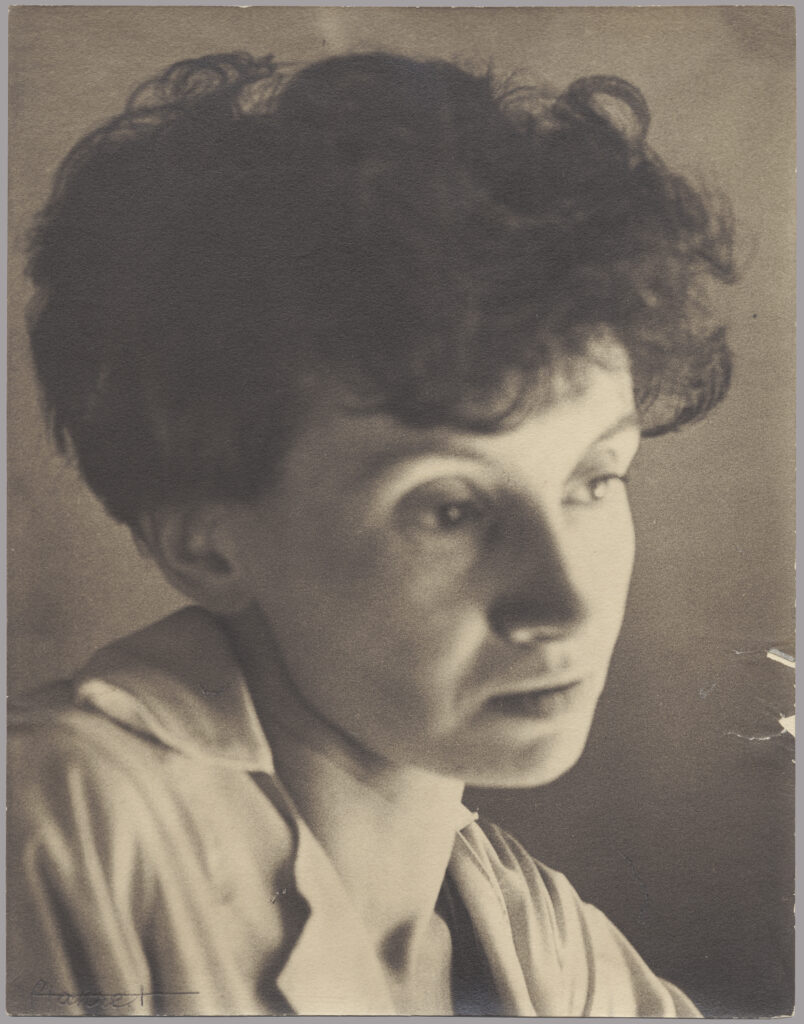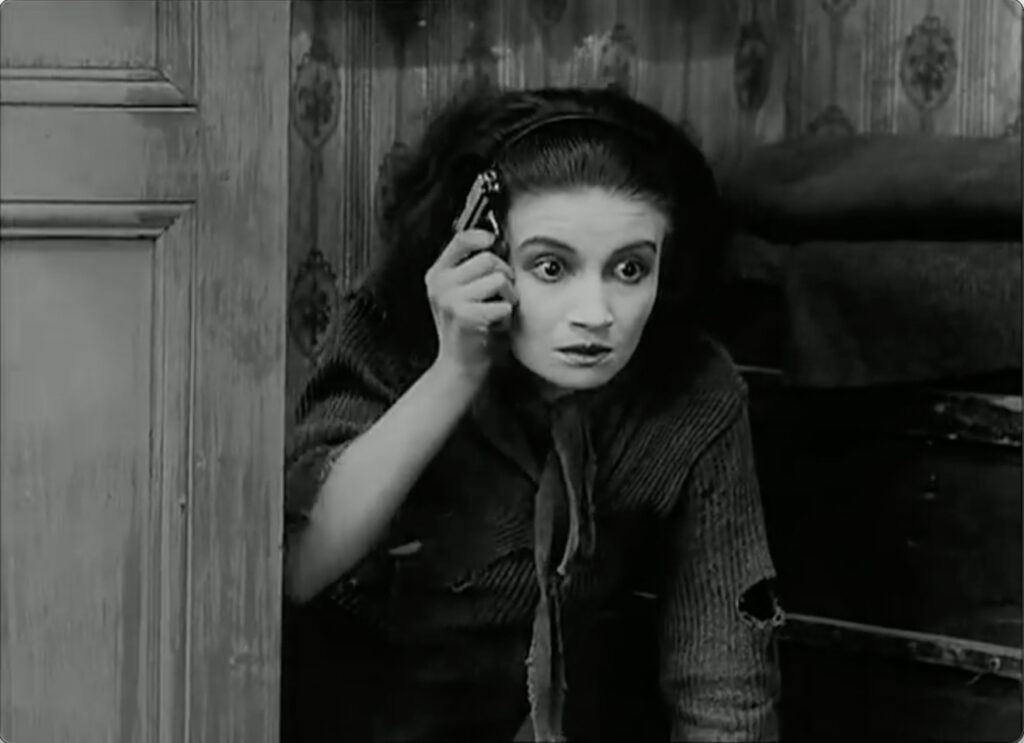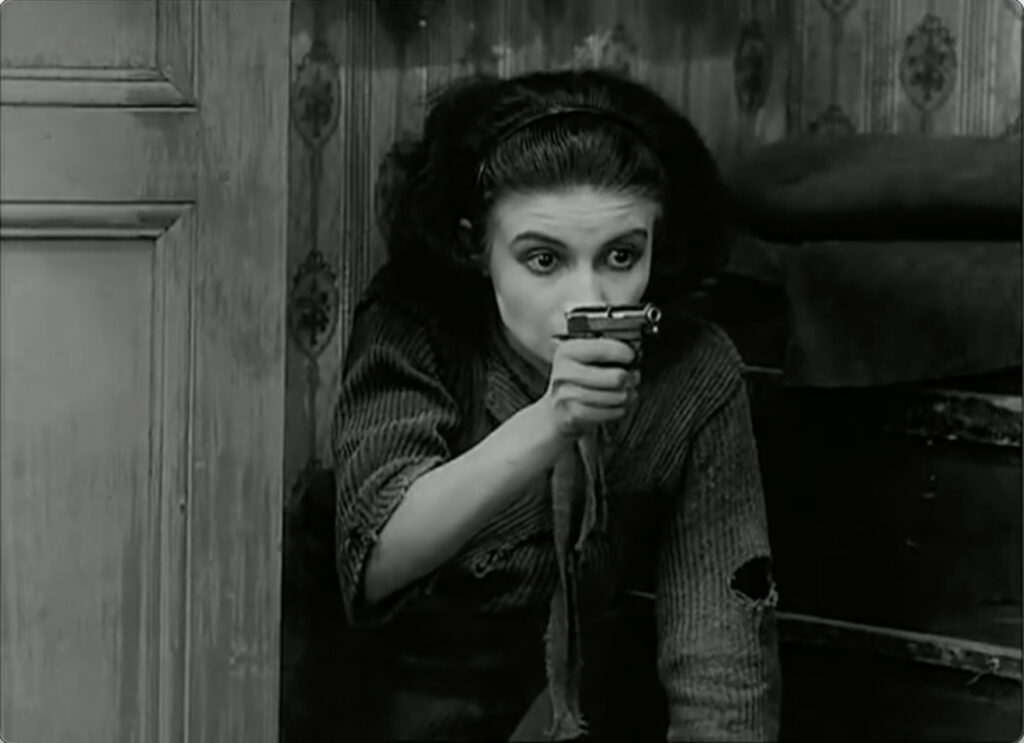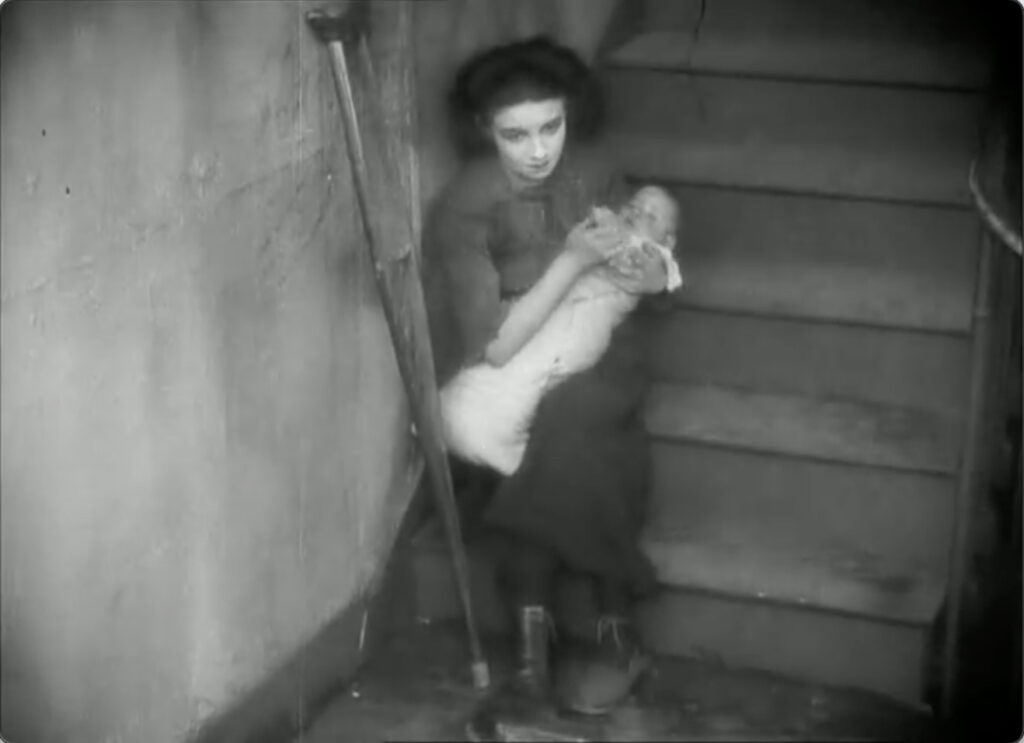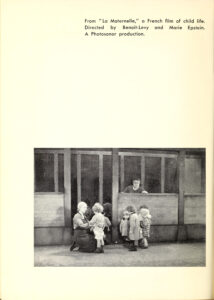Born to a French Jewish father and a Polish Catholic mother in present-day Poland, Marie Epstein moved to Switzerland with her mother Hélène and her brother Jean after the death of her father Jules in January 1907. The Epsteins later established themselves in Lyon, France, where Jean was completing his studies, and then in Paris around 1922, just a few months before Jean directed his first two feature films, L’Auberge Rouge (1923) and Coeur fidèle (1923). It was also in the early 1920s that Marie became involved in the world of cinema. She started as an actress—in L’Auberge rouge, where she appeared as an extra in just a few early shots (Flitterman-Lewis 143), and in Coeur fidèle, two films that she co-wrote with Jean—but found it difficult to secure more roles. She then turned fully to screenwriting, which led her to work as an assistant director and editor (EPSTEIN184-B40). Through the intervention of French director and producer Jean Benoit-Lévy, Marie also became a director at a time when there were few women filmmakers in France. After she had been Benoit-Lévy’s assistant on several silent film documentaries in the 1920s, she then co-directed, wrote, and edited eight sound fiction films with him in the late 1920s and 1930s. During that period, she also directed at least one short film on her own (EPSTEIN113-B26 3/3), possibly more. After World War II, and the death of her brother Jean in 1953, Marie was hired by Henri Langlois as a film preservationist at the Cinémathèque française, a job she held until her retirement in 1977.
Beyond this initial sketch, however, Marie’s film career is not easy to reconstruct with great precision. During the silent era, Marie was often credited for her contributions to the films she made with Benoit-Lévy, yet not in a consistent fashion across publicity materials, film periodicals, and newspapers. Further challenges, which will no doubt sound familiar to scholars interested in other women filmmakers from the silent cinema, have to do with the collaborative nature of Marie’s work and the scarcity of extant archival materials related to her contributions as a director, screenwriter, and editor. Although she worked relentlessly to preserve her brother Jean’s legacy from the 1950s through the 1970s, and to constitute the Jean and Marie Epstein collection at the Cinémathèque française, she rarely discussed or even documented her own film career in great detail. Finally, certain difficulties concerning Benoit-Lévy’s status as a Jewish filmmaker during World War II have emerged in recent years that further complicate one’s understanding of Marie. Yet, despite these challenges, traces of Marie’s work—and even perhaps her authorship—survive and call for our renewed attention.
What we do know—so far—is that Marie’s acting career apparently began and ended with Coeur fidèle, which was not very successful at the time of its release in 1923. Although Marie was under contract with Pathé-Consortium as an actress (Daire 63-64), the naturalism and sincerity of her acting style as the young disabled neighbor might have set her too far apart from the popular stars of the time, including her co-stars Gina Manès, Léon Mathot, and Edmond Van Daële. In any case, Marie quickly dropped acting and became a screenwriter full time. In addition to L’Auberge rouge and Cœur fidèle, Marie wrote the screenplays of several important films in the 1920s, such as L’Affiche (1924), Le Double Amour (1925), and Six et demi onze (1927), all directed by Jean Epstein; and Ames d’enfants (1927) and Maternité (1929), directed by Marie Epstein with Jean Benoit-Lévy. She even won a prize for Les Mains qui meurent in 1923 (awarded by Pathé-Consortium)—even though the film was never made—and this led to the complimentary comparison with filmmaker and critic Louis Delluc (“France finally had Louis Delluc. It now has Marie Antonine Epstein” [Henry]). However, only two other texts were published about her during her career (Doringe; Fescourt 402-8).
Although the five films she co-wrote with her brother—L’Auberge Rouge, Coeur Fidèle, L’Affiche, Le Double amour, and Six et demi onze—predate Marie’s work as a director, these films played a formative role in shaping her entire film aesthetic. Stylistic features such as the reiteration of figures, repetitions of haunting images from the past, the use of significant objects and recurring motifs, which later became characteristic of Jean’s highly evocative cinema, all find their way into Marie’s most accomplished work as a director, the sound film La Maternelle (1933). Furthermore, Marie’s own films—like Jean’s—often focused on the impact of an oppressive social milieu on a character’s inner life. And, finally, Marie’s role as a disabled woman who cradles the heroine’s sick child at the end of Coeur fidèle foretells her preoccupation with the themes of childhood, womanhood, and motherhood that abound in the fiction films she co-directed with Benoit-Lévy, mainly Ames d’enfants (1927), Peau de pêche (1928), and Maternité (1929).
Marie began working with Benoit-Lévy almost by accident. Her brother, who was Benoit-Lévy’s assistant, bequeathed his sister to the documentary director when he wanted to make films of his own. But perhaps because Marie willingly cast herself “in the shadows” of the men who surrounded her (Jean Epstein, Jean Benoit-Lévy, and, several years later, Henri Langlois), speculation about this origin story abounds. For example, in her book Le Cinéma des femmes (1987), Paule Lejeune surmises that Marie decided to follow the path of Benoit-Lévy because she would have been intimidated by the cinematographic forefront where her brother was, or because she would have preferred to guarantee an economic income to support her brother (52). But these speculations deny Marie’s artistic agency; her work with Benoit-Lévy, first as assistant on his documentary films, then as director on the fiction films, indicates a talent and a vision that we associate with significant auteurs.
What can be asserted (although this too is problematic) is that Jean Epstein’s focus on experimentation was geared toward an avant-garde audience, while Marie’s films with Benoit-Lévy, whose focus was on women, children, and the social challenges they faced, were accessible for all audiences. Benoit-Lévy’s socially committed documentaries (three hundred of them) were geared toward his principles of education and learning, toward progressive social politics, and toward issues often deemed “secondary” as they concerned women’s lives and social realities. The documentary form served his purpose well because he approached his material with the chronicling attention of a documentarist. But when he turned to fiction films, the sensitivity, insight, and artistic sensibility of his scenario-writing co-director gained a place of prominence. Marie brought a particular aesthetic from the silent films to the sound films of the thirties. Furthermore, she was instrumental in transposing Benoit-Lévy’s documentary concerns with social issues, particularly as they related to women and children (poverty, public health, neglect, single motherhood, education, ethical and moral choices, social responsibility) to the form of the fiction film, with its emphasis on female characters, that comprised their output in the twenties and thirties.
World War II put an end to their creative collaboration for the duration of the conflict. After one year in relative safety in the countryside, the Benoit-Lévy family, being Jewish, was forced into exile in New York City, where the director had been invited by the Rockefeller Foundation. This explains the somewhat mournful tone of Benoit-Lévy’s dedication in his book written in America: “When she reads these lines, I would like Marie Epstein to feel that all the professional joys and sorrows through which we have lived together are reflected in this essay on the art we both love. I am certain that, over there, in the country of tragic heroism, she, like myself, retains the hope that we shall soon be able to revive our old group…” (Benoit-Lévy 276). For her part, Marie, whose family had converted to Catholicism when she was young, was still seen by the authorities as a Jew. She was arrested by the Gestapo in 1944 but managed to avoid deportation and was released due to the intervention of friends in the French film industry and the Red Cross. The Benoit-Lévy family returned to France after the war, only to find their apartment, with its screening room and offices, vandalized. Nevertheless, Marie subsequently collaborated with Jean Benoit-Lévy on several documentary projects, including a film about the ballet, the first program broadcast on French television at its inception. This time, Marie worked with Benoit-Lévy as an assistant instead of a co-director (which was also the case for the last film they made before the war: Feu de paille, 1940). She also wrote scenarios for other filmmakers (e.g., La Grande Espérance [1953] by Léonide Azar, Liberté surveillée [1958] by Henri Aisner and Vladimir Vlcek) after Jean Benoit-Lévy quit filmmaking. She finally joined the Cinémathèque française to restore films, especially those made by her brother who died the year she was recruited to work at the organization run by Henri Langlois (Cauquy and Frappat).
At the time of her work with Benoit-Lévy, Marie Epstein was acknowledged in the film world by at least one prominent critic, Henri Fescourt, who said, “Marie Epstein, who stands in the shadows because she is too discrete, is one of the most complete cinéastes, as much for her ideas as a scenarist, as for her work as a director and editor. She was, for both her brother and for Jean Benoit-Lévy, a collaborator of the most inestimable efficacity” (Fescourt 311). Still, this did not prevent her from being totally unknown to English speaking audiences until Langlois’s death in 1977, at which point American feminist Sandy Flitterman-Lewis was able to interview her and screen her films. This resulted in Marie Epstein’s career being treated in To Desire Differently: Feminism and the French Cinema published in 1990, and in some of her films being shown at the Festival de films de femmes de Créteil in 1991, which led to Marie’s increased and continuing visibility.
However, for reasons having to do with both the archives and the collaborative nature of Marie’s work with Benoit-Lévy, it remains difficult to this day to research her film career. On the one hand, after 1940, Benoit-Lévy’s documentary films saw their authorship transferred to non-Jewish filmmakers in the process of Aryanization adopted by the French government. The Benoit-Lévy family is still trying to have authorial designation returned to Benoit-Lévy; because of this, speculation about gender concerns in the fiction films that Benoit-Lévy and Marie directed together has the danger of falling into a conventional (and misleading) attribution. More fruitful, perhaps, is the way that Benoit-Lévy’s chosen subjects (often involving powerful single women or childhood trauma brought on by poverty and neglect) were amplified by Marie’s stylistic choices, including the use of experimental editing techniques reminiscent of her brother’s silent films, such as rapid cutting, repetitions, and disparate images of memory or fantasy. Fiction films that preceded the attested directorial collaboration include La Future Maman (1925) and Le Voile Sacré (1926), but Marie’s influence is clear even though these films do not list her as co-director, and they act as prelude to the fiction films of the thirties.
On the other hand, questions arise as to the division of labor in her collaboration with Benoit-Lévy. What part did she really have in her collaboration with him? In an interview, Marie stated that the collaboration with Benoît-Lévy was so close as to render each person’s part indistinguishable from the other: “This answers all the questions of well-meaning people who always want to settle a collaboration and know: ‘Who did this?’ and ‘Who did that?’ There are two of us who did this and that, the good and the not so good” (Vincendeau, “Enthousiasmes” 80–83). Perhaps a bit modestly, she has asserted that, while Benoit-Lévy could have made the films without her, she could not have done so on her own. But it seems probable that this modesty is something of an exaggeration; her authorial signature is apparent everywhere in these films. On a more personal note, Marie was treated like a member of the Benoit-Lévy family, and professional life merged with private life, as some family pictures of costume parties and the like demonstrate. Although she never married or had children herself, she treated the Benoit-Lévy girls like daughters, and they in turn treated her like a beloved aunt.
Nevertheless, we can find some hints in Jean Epstein’s interview with Musidora in 1946: “my sister who collaborated with Benoit Lévy, while she was mostly doing the artistic part of the film and he was doing the administrative part” (Epstein). But this might also create more problems than it solves, and bespeak of a prejudice retained by Jean Epstein from the early days of his working with Benoit-Lévy. The subjects for the films, at least for La Maternelle, Hélène (1936), and Itto (1934), all came from Benoit-Lévy himself, first from his devotion to and friendship with Léon Frapié, whose writing inspired La Maternelle, then from his admiration for Vicki Baum’s novel, and finally out of a desire to critique Pierre Loti. While it may be true that the most experimental sequences in these films came from Marie’s editing and poetic vision, Benoit-Lévy did far more than accounting. The question of the collaboration process persists, but the closeness of these two filmmakers goes without objection.
To conclude, Marie Epstein’s story is a complex one that changed over the years as opinions shifted and new elements came to be considered. Although she has been more visible since the 1970s than she was during most of her film career, many questions remain unanswered, making it difficult—yet not impossible—to speculate about her work. What can be said with confidence, however, is that Marie Epstein wore many hats, from actress to screenwriter to director to editor and preservationist, and that her presence in many areas of French cinema and French film culture was not only long-lasting but also impactful. The full extent of her influence remains to be seen.

